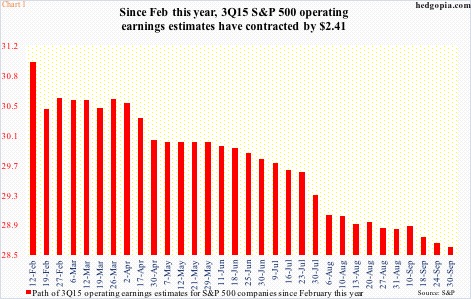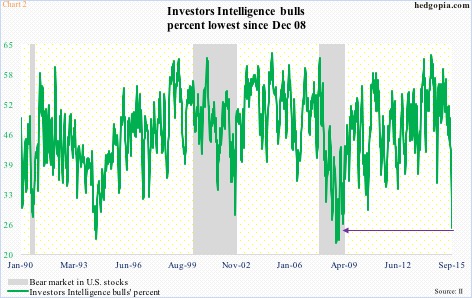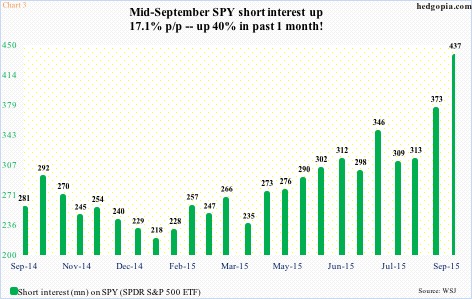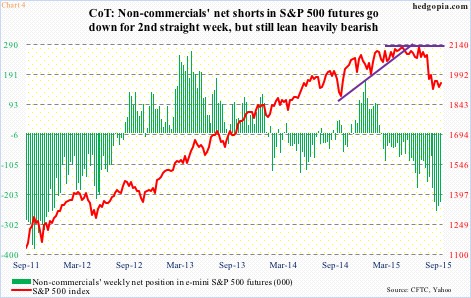Third-quarter earnings season begins in earnest this week. Operating earnings estimates for S&P 500 companies have been persistently coming down for 2015 – from as high as $137.52 at the end of the second quarter last year to $110.98 as of September 30th!
Quarterly estimates obviously are on the same trajectory. During the same period, estimates for the third quarter have gone from $34.86 to $28.61 (Chart 1 only goes back to February this year.) If 3Q estimates are met, earnings would still be down 3.3 percent from last year’s $29.60. For the year, earnings are slated to drop 1.8 percent.
The revision trend is clearly down. Stocks are beginning to reflect this. As is sentiment.
Last week, the percentage of bulls in Investors Intelligence’s weekly survey dropped to 24.7 – the lowest since 23.1 in December 2008 (Chart 2). Bears, too, jumped 4.9 points to 35.1, but their ranks have not risen enough, as they have in the past, to indicate an important bottom in stocks. The reason is those in the correction camp, which has been stuck in the 40s for the last nine weeks. Bulls, on the other hand, have just about given up.
A similar rapid shift in sentiment is also reflected in the short interest data. We don’t yet have end-September numbers (they will be published this Friday), but as of the middle of September short interest on SPY, the SPDR S&P 500 ETF, stood at a massive 437 million, and has gone up 40 percent in just one month (Chart 3). The picture is the same elsewhere. Short interest on QQQ, the PowerShares Nasdaq 100 ETF, has gone up 84 percent in the past month and a half, and on IWM, the iShares Russell 2000 ETF, 19 percent in the past couple of months (QQQ and IWM not shown here).
As far as the S&P 500 is concerned, there is a similar message coming out of the futures market. As of August 25, a day after the index made an intra-day low of 1867, non-commercials’ net shorts in e-mini S&P 500 futures were 75,744 contracts.
Then the index went on to rally eight-plus percent by September 17. Throughout this, these traders continued to add, peaking at 258,900 by September 15. They were not convinced the rally was real, and were vindicated in some ways in that the index did come under renewed pressure, dropping to 1872 by September 29. In the meantime, net shorts have been reduced to 227,575. These are still massive holdings.
The question is, how might last Friday’s reversal in U.S. stocks have impacted non-commercials’ conviction, if at all? We would not know until Friday.
If we see a sustained drop in both SPY short interest and non-commercials’ net shorts, this rally may have legs. If not, it is bound to soon fizzle out.
The Friday reversal is important, but important enough to nullify all the technical damage wrought on major U.S. indices by the August sell-off? Probably not. On the S&P 500, from monthly bearish MACD crossover (in April this year) to the index dropping below its 20-month exponential moving average in September, there are tons of reasons to worry long-term.
Even so, we cannot just shut eyes to Friday’s action. Near-term, odds have grown SPY ($195) will at least test resistance at $198-$199. The declining 50-day moving average lies at $199.59. The daily MACD has crossed up, and momentum indicators are oversold. In the meantime, VIX seems to want to go lower – a certainty once/if it loses its 50-day moving average, which it is currently sitting on. This could be setting up well for a strategy to generate income using short-term options – cash-secured puts to be precise.
Hypothetically, October 9th weekly 192.50 puts are selling for $1.07. SPY options are currently priced for it to move just below $4 this week – either up or down. If the options market is right, and the ETF makes a move to the downside, it is a long at $191.43. If the move is to the upside, the ETF will go test that afore-mentioned resistance, and the premium is kept.
Thanks for reading!
Please keep in mind that this article was originally published early today by See It Market, where I am a contributor.

